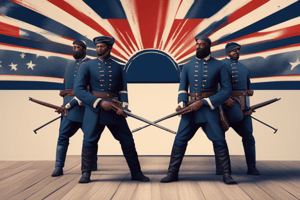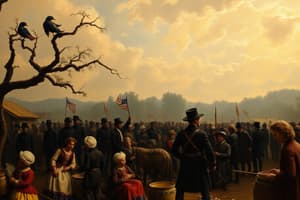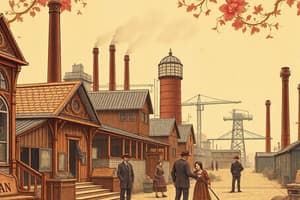Podcast
Questions and Answers
What was the primary economic system of the South before the Civil War?
What was the primary economic system of the South before the Civil War?
- Agricultural, reliant on slave labor (correct)
- Industrial manufacturing
- Trade-based economy
- Mixed economy with no reliance on slavery
The Missouri Compromise successfully resolved all tensions related to slavery between the North and South.
The Missouri Compromise successfully resolved all tensions related to slavery between the North and South.
False (B)
Name a significant event that fueled anti-slavery sentiment in the North.
Name a significant event that fueled anti-slavery sentiment in the North.
Uncle Tom's Cabin
The ___________ Act of 1850 required Northerners to assist in capturing runaway slaves.
The ___________ Act of 1850 required Northerners to assist in capturing runaway slaves.
Match the following events to their outcomes:
Match the following events to their outcomes:
Which of the following best describes the working relationship between the North and the South leading up to the Civil War?
Which of the following best describes the working relationship between the North and the South leading up to the Civil War?
Abolitionist movements were primarily found in the South, pushing for the end of slavery.
Abolitionist movements were primarily found in the South, pushing for the end of slavery.
What was the main concern regarding the expansion of slavery into new territories?
What was the main concern regarding the expansion of slavery into new territories?
Flashcards
Republican Party Formation
Republican Party Formation
The Republican Party was formed to oppose the expansion of slavery, illustrating growing divisions in the United States.
Lincoln's Election Triggered Secession
Lincoln's Election Triggered Secession
The election of Abraham Lincoln, who opposed slavery's expansion, triggered Southern states to secede from the Union.
Southern States Secession
Southern States Secession
Southern states believed their interests were no longer represented and felt compelled to leave the Union.
South Carolina's Secession
South Carolina's Secession
Signup and view all the flashcards
Fort Sumter Attack
Fort Sumter Attack
Signup and view all the flashcards
North vs. South Economy
North vs. South Economy
Signup and view all the flashcards
Tariffs and Economic Conflict
Tariffs and Economic Conflict
Signup and view all the flashcards
Slavery and Abolitionism
Slavery and Abolitionism
Signup and view all the flashcards
Slavery Expansion and Power Balance
Slavery Expansion and Power Balance
Signup and view all the flashcards
Missouri Compromise
Missouri Compromise
Signup and view all the flashcards
Fugitive Slave Act
Fugitive Slave Act
Signup and view all the flashcards
Bleeding Kansas
Bleeding Kansas
Signup and view all the flashcards
Dred Scott Decision
Dred Scott Decision
Signup and view all the flashcards
Study Notes
Economic Differences
- The North developed an industrial economy based on manufacturing and trade, while the South remained largely agricultural, reliant on slave labor for its cotton production.
- This economic disparity created different needs and priorities. The North favored tariffs to protect its industries, while the South opposed them, seeing them as harmful to their export trade.
- This led to growing tension and conflict over economic policies, with each region developing distinctive political interests.
Slavery and Abolitionism
- The institution of slavery was fundamental to the Southern economy, deeply ingrained in its social fabric.
- Abolitionist movements in the North gained momentum, advocating for the immediate end of slavery. Radical abolitionist groups and individuals actively worked to spread anti-slavery ideas.
- The issue of slavery's expansion into new territories became a major political battleground, as it threatened to upset the delicate balance of power between free and slave states in the national government.
- Events like the Underground Railroad and the publication of Uncle Tom's Cabin further fueled anti-slavery sentiment in the North.
Political Compromises and Tensions
- The Missouri Compromise (1820) and the Compromise of 1850 attempted to resolve the slavery issue by balancing the admission of free and slave states. However, these temporary fixes only exacerbated underlying tensions.
- The Fugitive Slave Act of 1850 required Northerners to assist in the capture and return of runaway slaves, causing considerable animosity in the North.
- The Kansas-Nebraska Act (1854) repealed the Missouri Compromise, permitting popular sovereignty in these territories, escalating violence and further dividing the nation. "Bleeding Kansas" highlighted the breakdown of compromise.
- The Dred Scott Supreme Court decision (1857) declared that Congress could not prohibit slavery in the territories, adding fuel to the fire and provoking outrage in the North.
Growing Sectionalism
- The differing cultural values and political priorities of the North and South created strong feelings of sectionalism.
- Politicians and citizens increasingly identified themselves primarily as Northerners or Southerners rather than as Americans.
- The rise of powerful political figures like Stephen Douglas and Abraham Lincoln further polarized the nation, as their debates highlighted fundamental disagreements over slavery.
- The formation of new political parties like the Republican Party, explicitly opposed to the expansion of slavery, signaled the growing political divide.
Immediate Causes Preceding the Civil War
- The election of Abraham Lincoln in 1860, who opposed the expansion of slavery, was met with outrage in the South.
- Southern states began seceding from the Union, believing their interests were no longer represented.
- South Carolina was the first to secede, followed by other Southern states.
- The attack on Fort Sumter in April 1861 marked the beginning of the Civil War, as the Confederate forces initiated hostilities.
- The immediate trigger for the violence was the dispute over federal forts in the South. The Confederate attack on Fort Sumter acted as the immediate catalyst for the conflict.
Studying That Suits You
Use AI to generate personalized quizzes and flashcards to suit your learning preferences.
Description
Explore the stark economic contrasts between the North and South during the pre-Civil War era. This quiz covers the impact of slavery on Southern society and the abolitionist movements gaining traction in the North, examining the political tensions that arose from these disparities.




